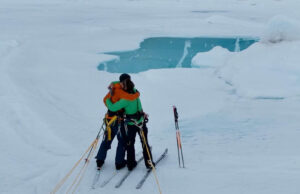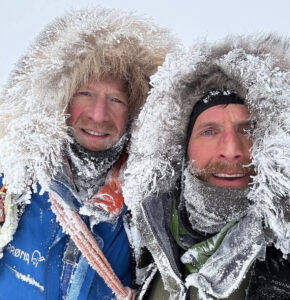In our latest arctic roundup, Will Steger stocks up on provisions, a threesome complete their 310km ski tour of the North Water Polynya, and the Axel Heiberg team grind up and over the island’s ice cap.
The Barren Lands
Seventy-seven-year-old Will Steger continues to make great progress on his second bash at a 1,600km ski/canoe expedition through Canada’s Barren Lands. Steger covered around 320km over his first two weeks before switching to overnight travel on May 15 to take advantage of cooler temperatures and firmer snow.
Steger’s switch to nighttime travel corresponded with his arrival at Lake Kegelkavig. “Clear and cool temperatures made for easy travel,” he said.
He crossed the lake in just three days. Steger had planned for a bush plane resupply on May 22, but strong winds delayed his arrival by a day. On May 23, his friend Dave Olesen flew in, and Steger reloaded his canoe with food and fuel.
“First day on the White Sands River. Very heavy load after yesterday’s resupply. Now entering deeper water levels,” Steger explained in his most recent update.

Will Steger is best known for his 1986 dogsled journey to the North Pole and his 1989-1990 dogsled traverse of Antarctica. File photo from a previous expedition. Photo: Will Steger
Devon Island
Canadians Dave Garrow, Frank Wolf, and John McClelland completed their 310km ski tour of the North Water Polynya today. The trio spent 20 days on the ice, starting and ending in Grise Fiord. The trip took in an ecologically important area of open water in Baffin Bay in the Canadian High Arctic.
Axel Heiberg Island
John Dunn and Graeme Magor’s two-month, spring-summer ski traverse of Axel Heiberg Island began in late April. The pair have now crossed over the ice cap after a difficult slog up. “Slowly up the Strand…two sleds at a time, 15km equals 5km of progress. At the end of our shift, the tent is a haven of comfort,” they wrote on May 17.
After the col, they had an easier time descending during a “windless, relaxing, easy run on perfect snow to the glacier toe.”
They are also now on the dry side of Axel Heiberg, so the snow is much better. The snow comes from the west/northwest and the high peaks of western Axel catch it, leaving the east side very dry and perfect for sledding.
John Dunn’s tracker shows the team’s progress across Axel Heiberg Island.
It’s taken them almost a month to get roughly halfway across the island but they should find the second half substantially easier. They will soon stash one sled each and will travel more on sea ice for a while, which should make the going faster. They have chosen to dispense with the weight of a firearm and will rely on the fact that traditionally at least, few polar bears venture as far as the northern half of Axel Heiberg.






